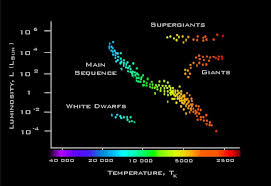Overview
Stellar evolution is the theory of the life cycle of stars. Scientists observe many different stars at various stages, starting with the earliest condensations from clouds of nebular gas and dust. Once the temperature is high enough in a star’s core, hydrogen atoms begin nuclear fusion to helium. Eventually, hydrogen is depleted in the stellar core, so nuclear reactions involving helium lead to stages of expansion, explosion, and collapse.
The Study of the Life Cycle of Stars
Even the largest stars exist for millions of years, so one star cannot be studied through the entire time they burn. However, many different types of stars shine throughout the entire universe, so astrophysicists observe stars, compare and correlate data, and form hypotheses about how stellar material might behave. Many different observations are used, from the unique chemical signatures of elements and compounds as they burn, to the behavior of subatomic particles and energy throughout the universe. Many observations are possible because of advances in technology that allow fainter objects to be seen from greater distances away. Observatories have been located in many parts of the world, and space telescopes make data gathering possible without interference from the atmosphere.
Planets, Brown Dwarfs, and Protostars
Interstellar gas and dust normally collect in a cloud called a nebula. The smallest blobs form planets that may orbit around a star. If the blob is between the size of the planet Jupiter and .08 times the mass of the sun, it may become a brown dwarf, unable to produce energy on its own. A blob about the mass of the sun to much larger than the mass of the sun will contract and produce heat and light of its own, mostly from kinetic and gravitational energy. It becomes a protostar, in a process that lasts 10,000 or more years. Astronomers have discovered protostars in many nebulae (pl. of nebula), and are gathering data from many observations. Typically, protostars don’t give off light in the visible spectrum, but infrared light or microwaves.
Hydrogen Fusion
As the protostar condenses, giving off heat and light, the temperature increases as the core forms. When the temperature reaches 106 Kelvin, the protons within hydrogen fuse to become helium, releasing even more heat and light. Stars are powered by nuclear fusion for most of the time they shine. Most stars combine hydrogen atoms to form helium, similar to the process in a hydrogen bomb.
The “Main Sequence”
Astronomers named Hertzsprung and Russell plotted a number of stars on a graph using their temperature (or color) on the x axis and their absolute brightness (or magnitude) on the y axis. Most stars fell along a band on the graph called the main sequence. According to theories of stellar evolution, most stars spend most of their time somewhere on the main sequence.
Interested in science tutoring services? Learn more about how we are assisting thousands of students each academic year.
SchoolTutoring Academy is the premier educational services company for K-12 and college students. We offer tutoring programs for students in K-12, AP classes, and college. To learn more about how we help parents and students in Wheaton, IL: visit: Tutoring in Wheaton, IL




